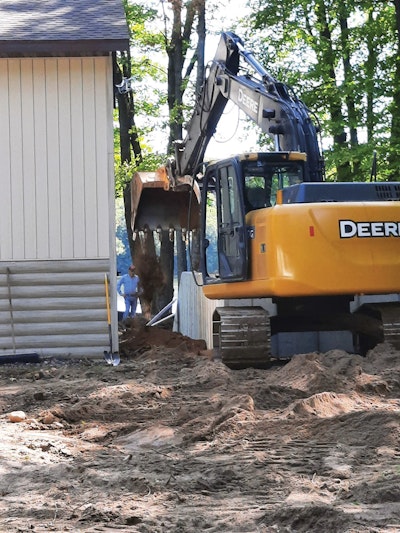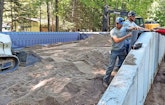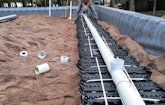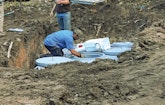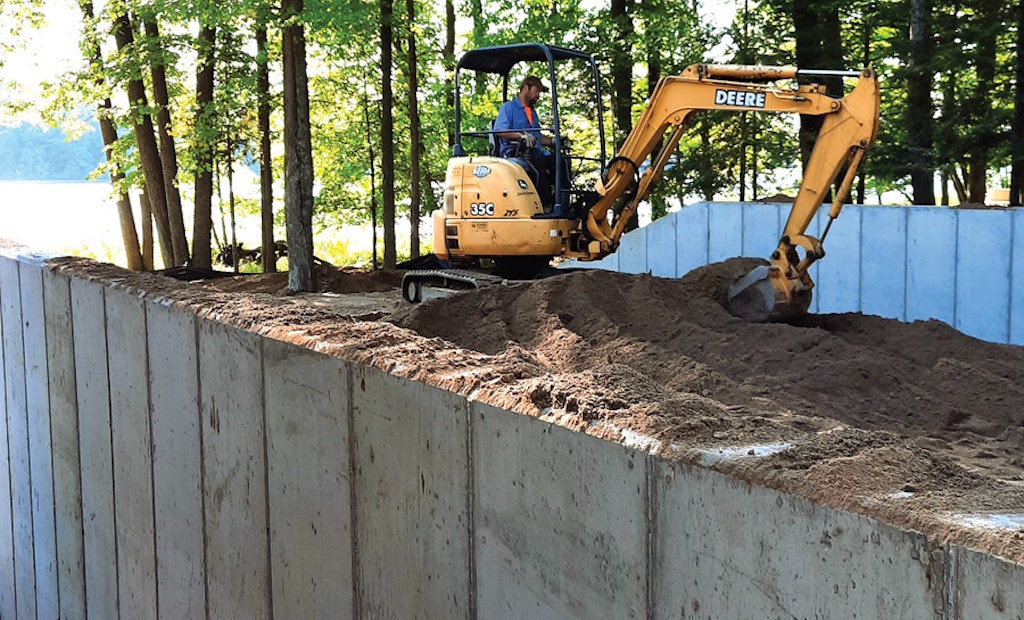
Mark Yohnk with Stolt Excavating uses a John Deere 35C ZTS mini excavator to move septic sand inside Eljen’s Mound in Box. (Photos courtesy of Mark Prevost)
Interested in Systems/ATUs?
Get Systems/ATUs articles, news and videos right in your inbox! Sign up now.
Systems/ATUs + Get AlertsOwners of a three-bedroom seasonal lakefront cottage in Ladysmith, Wisconsin, wanted to make it their permanent residence and build an addition. A 2,000- to 3,000-gallon concrete holding tank was the typical septic upgrade for Lake Flambeau residents, but the homeowner didn’t want to deal with routine pumping.
An onsite consultant recommended designer/installer Joe Rubenzer, proprietor of Stolt Excavating in Bloomer, Wisconsin. “Due to setbacks, a 3% grade, and lack of space, no typical system would fit on the lot,” he says.
Rubenzer asked Mark Prevost, from First Supply and an Eljen distributor, and CeCe Rudnicki, wastewater specialist and plan reviewer with the state Division of Industry Services, to meet him at the site. After a soil test confirmed they could install a mound, they discussed how to do it.
The team worked weeks measuring and laying out designs on-site. “We even brought in Jim King, president of Eljen, before finding the solution — an Eljen GSF Mound in a Box,” says Rubenzer. “However, it still wouldn’t fit on the lot without county and state variances for setbacks.”
The mound also had three sides instead of four, with the toe extended to provide sufficient basal area for effluent to assimilate into native soil. The alteration made this an individual site design that required Rudnicki’s in-depth review.
Site conditions
The 0.35-acre lot has silty loam soil with an application rate of .4 gpd per square foot. Depth to limiting factor is 14 to 20 inches.
System components
Rubenzer designed the system to handle 450 gpd. Major components:
- 1,000-/600-gallon combination precast septic/pump tank and risers (Huffcutt Concrete)
- 4-inch PL-525 effluent filter (Polylok)
- STF-100A2 pressure filter (Sim/Tech Filters)
- 0.4 hp Model PE41M effluent pump (Goulds Water Technology, a Xylem Brand)
- 24 A42 sand filter modules (Eljen)
- Installer Friendly Series Single Phase Simplex control panel (SJE Rhombus)
System operation
All piping is PVC Schedule 40.
Wastewater gravity flows 48 feet through the 4-inch house lateral with two 45-degree elbows to the septic chamber, then effluent drains to the pump chamber. Every 286 minutes, the pump runs 1.56 minutes, sending 39.6 gallons through the 2-inch force main 60 feet to the manifold dosing the 55-by-28-foot-wide drainfield.
Effluent disperses through four 25-foot-long rows of six modules separated by 8.25 feet. Above the modules, the 1.50-inch distribution laterals are sleeved in 4-inch perforated pipe. Each lateral has 10 (3/16-inch) orifices 30 inches apart, with four facing up and the fifth pointing down for drainage. After the liquid passes through the interwoven plastic corrugated core and black geofabric, it discharges to 22 to 36 inches of C-33 washed sand over native soil.
Installation
A forester cut three marked pine trees, leaving the stumps flush with the ground per code. Consequently, Rubenzer upsized the mound based on the stump area’s square footage, then workers scarified the soil and covered it with C33 sand brought in with a Bobcat T595 tracked skid-steer. They also stockpiled sand at the toe of the mound.
To protect the sand from freezing inside the 55-by-30-foot-wide box, Rubenzer’s crew dug 4-foot-deep load-bearing frost walls. (The frost line is 3 feet below grade.) Once Tri-City Concrete poured the 10-inch-thick walls, the cement took two weeks to cure in the August heat.
The box was 5 feet from the house and 3 feet from the wooded property line. When the crew returned, they insulated the inside walls with 2-inch-thick R10 foam board, then covered it with 6-by-100-foot rolls of Harvey 40-mil PVC shower pan liners (Oatey). After attaching the top of the liner to the top of the walls with duct tape, they joined the overlapping seams with Oatey’s X-15 Bonding Adhesive. Careful installation of sand held the liner tightly against the insulation as the crew built the mound.
Driving the skid-steer, Dan Stolt transported the stockpiled sand on the road to the box, as Forest Clements backfilled using the John Deere 135G excavator. Mark Yohnk worked his John Deere 35C ZTS mini-excavator between the house and box, then maneuvered inside it to level and compact 3 feet of sand. Together, Rubenzer’s two Kenworth T800 dump trucks hauled more than 400 tons of sand and 100 cubic yards of topsoil in 30 loads from the quarry a half hour away.
The 24 modules installed smoothly. As the crew trimmed the excess liner flush with the surface of the mound, Clements reversed the excavator and dug the hole for the 12-by-6.5-foot-wide septic tank. It was bedded on 6 inches of sand and the lid covered with 2-inch foam board insulation before backfilling.
“This project’s biggest challenge was the amount of thinking and planning that went into it,”says Rubenzer. “We completed the straightforward installation in three days.”
Because the Mound in a Box was a first in the area, Prevost invited members of the Turtle Flambeau Flowage & Trude Lake Property Owners Association to observe the installation. Prevost, King and Scott Moore, also from Eljen, were available to answer questions.
“Eleven people responded and, as noon approached, our client grilled hamburgers and hotdogs for everyone,” says Rubenzer. “We did visit some properties in the following weeks, but those homeowners found pumping a holding tank more affordable.”
Maintenance
Stolt Excavating maintains the system and Northwest Sanitary pumps the tank.
